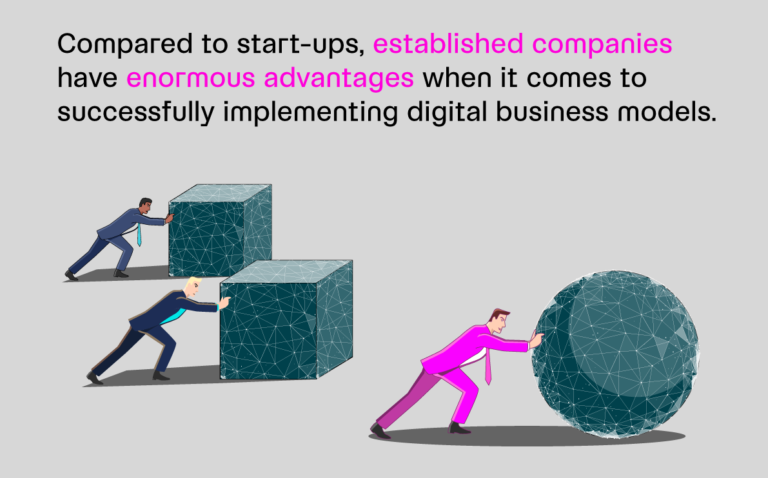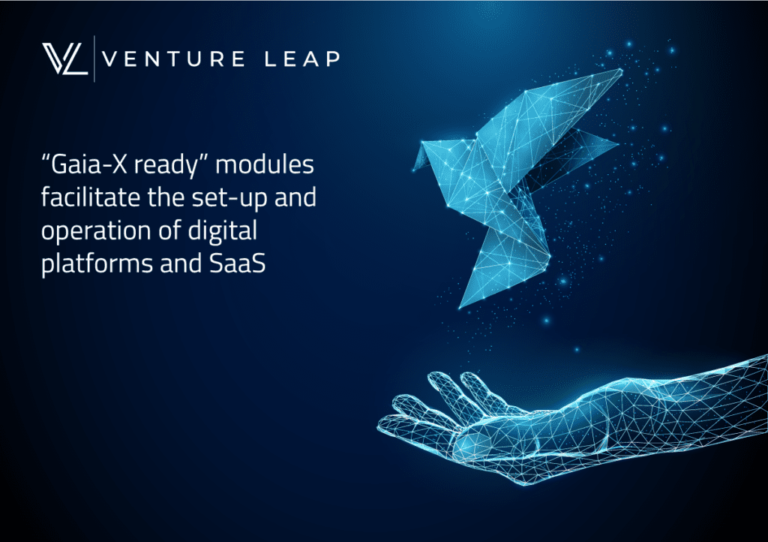Digitalisation is not just around the corner – it’s already here. Digital transformation is fundamentally changing our economy. For small and medium-sized enterprises it is the central challenge of the near future. The question is: How can digital transformation for SMEs succeed? At the same time, digitalisation also offers opportunities. Because by no means have all SMEs embarked on digital change. By swiftly implementing new processes, developing changed business models and modern customer service, you will set yourself apart from your competitors. But do SMEs understand these opportunities and implement the necessary processes?
In this article we want to clarify what digitalisation actually means for SMEs. After all, digitalisation is a very broad term and is always approached in different ways.
Subsequently, we will identify the central elements of a successful digital transformation of SMEs. You will receive a guide to answer the question: Where do I stand with my company in terms of digitalisation? Am I seizing the opportunities and mastering the challenge?
Three levels of digital transformation for SMEs
Digitalisation is a big word that leaves a lot of room for interpretation. Therefore, we will break down what digital transformation means for SMEs.
1) Digital infrastructure – the basis of digital transformation for SMEs
It may sound trivial, but the first step of digitalisation is to provide Internet access, computers, and software internally, and websites and social media channels externally. Internal communication then runs digitally via various tools.
Almost all companies in Germany today fulfil this basis of digitalisation.
2) Networked information and communication
Big Data has been a buzzword for digitalisation in recent times. It is about your analysis and evaluation. Digitalisation means that data is available in a consistent form and can be processed in different systems, and in the next step new business models can be built around the collected data.
Another example of networked communication is the triumph of Cloud ERP and CRM solutions. Whereas individual systems such as accounting and logistics used to take a long time to standardise data, important KPIs such as sales, stock levels, returns and waste produced now converge on a single interface.
The software is provided as SaaS (Software a Service). This means that access to the data is no longer location-bound and can be conveniently carried out from any device with internet access. The advantages of such a fully digital data structure are obvious. Problems in everyday business are identified more quickly and can therefore also be solved more quickly.
3) Networked products and services
A lot has been written about the Internet of Things in recent years. Its importance is already being felt by every single person in everyday life. A common example: the pizza from the delivery service. In the past, you simply called the delivery service of your choice, ordered the pizza and then received a delivery time. Then you had no choice but to wait and see.
With the Internet of Things, i.e. the increasing networking of objects and services, this is changing. Nowadays pizza is ordered via an app. The suggestions for the delivery service are based on an individual user profile and an evaluation algorithm. You pay online. Afterwards you will automatically be shown a delivery time – which is always adjusted, because the driver and the delivery service are networked with the app and constantly send data to the system, from which the delivery time is calculated.
For companies this is both a challenge and an opportunity.
Challenge: With the Internet of Things, the image of the customer must change.
Customers increasingly expect all products and services to be as convenient as they are used to in everyday life. All companies must react to this in the medium term.
The systematic recording and servicing of customer requirements means a great deal of effort. Depending on the industry, suitable tools must be found for tracking and analysis. Satisfying dynamically changing customer needs also requires agile structures and processes that take time and cost to implement.
Opportunity: At the same time, there is potential for companies to position themselves better in all-round networking. Big Data enables companies to understand their customers better and better and meet their needs more accurately. Those who succeed in translating these needs into products and services are one step ahead of the competition.
Where do you stand as a company in the digitalisation process?
Precisely because digitalisation is such a comprehensive process, many companies find it difficult to position themselves in the context of digitalisation: Where do I stand as a company and what steps do we need to take next to drive the digital transformation?
Four central elements work together for a successful transformation.
The chassis: digitalisation strategy
Digitalisation affects all business processes and changes them fundamentally. Without a comprehensive strategy covering all areas and identifying appropriate measures based on a clear definition of objectives, digitalisation efforts will quickly lead to nothing or to chaos.
The motor: business model and customers
The strategy forms the basis for a successful digital transformation in the company – but it only gets exciting when it is implemented. Every digitalisation strategy ultimately also affects the business model itself. This must be adapted to the digital challenges.
The change in business model may not always be visible to the customer. It can also be directed primarily inwards and focus on improving efficiency within the company. This is the case, for example, when it comes to the conversion from traditional SAP solutions to modern cloud ERP solutions.
However, the digital transformation of SMEs is often also about changing the business model itself. The central question here is: How can we meet changing customer requirements while using as many of our existing resources as possible to shape this change?
The drivers: culture and leadership as the basis for dynamic structures and processes
Digitalisation does not only describe technical innovations. Digitalisation is linked from many sides to a modified corporate and management culture. The difficulty here is that a corporate culture cannot be imposed from above. It grows from the company and its employees.
A change in culture must therefore start precisely there. This applies both to employees and management.
Employees: Many employees have reservations about digital transformation processes. They relate to fears of working on the abolition of their own workplace and with a general unease about disruptive changes that also affect their own way of working. But even if employees are open to digital processes, they need skills and knowledge to meet the new requirements with confidence. For example, they need to learn how to use new tools and how to work flexibly.
Management: An even more important factor for the success of the digital change is the management of the company, from the board of directors to the senior executives. Traditional corporate cultures are systematically opposed to successful digitalisation in many respects. These include, for example, the absence of an error culture and the undynamic design of processes.
Have you already worked on training your employees and managers? Do you have an employee who explicitly takes care of change management in the company? Then you are well on the way to laying the foundations for a corporate culture that meets the requirements of digitalisation.
The fuel: agile processes and structures
While strategy, business model, and corporate culture are rather large and overarching issues, digitalisation affects every single work process in a company. It is only at this micro level that it becomes clear whether the efforts are successful. The central question here is how agile your processes are structured.
Agile processes are a buzzword primarily known through the IT industry. For software development, approaches have been developed that do justice to the complexity of development projects and map them better than classic project management frameworks. But with digitalisation, the advantages of an agile approach are also becoming clear for other industries and sectors. New projects can be started dynamically and in a timely manner, as in agile structures, not all details are determined at the beginning. This allows you to react more flexibly to the changing requirements of customers and partners in the project.
The implementation of agile processes often fails because of culture. Because agility means abandoning classic deadlines and a zero-error policy. Classical management styles often cannot cope with this.
Ask yourself which project management frameworks are implemented in your company. Do you still use classic linear methods? Then you will find it difficult to keep up with the pace of digital transformation.
Conclusion: shape digitalisation now
Digitalisation must take place at different levels. The basis is always a functioning digital infrastructure. This is the foundation for networking communication, both internally and externally. By means of modern software solutions, all company data converge in one interface and are evaluated there. Comprehensive networking does not only take place internally. The products and services themselves are also increasingly networked. This enables companies to tailor their products more precisely to customer needs and increase sales and customer satisfaction.
Shaping the levels requires a well-thought-out digitalisation strategy. This strategy defines goals and means to achieve these goals. But digitalisation also affects the core of every company – the business model. This must also be reviewed as part of a transformation process. Does it still suit modern customers, or does it need to be changed or extended? These considerations must also be accompanied by a cultural change. Traditional corporate cultures are often hierarchical and are opposed to agile approaches that are better suited to tackle the problems of digitalisation. In the end, how well digitalisation succeeds in a company depends precisely on these agile structures.
At Venture Leap, we help SMEs leaders with their digital transformation strategy and execution. Get in touch or book a free session below if you want to know how digital product development and digital transformation go hand in hand.




